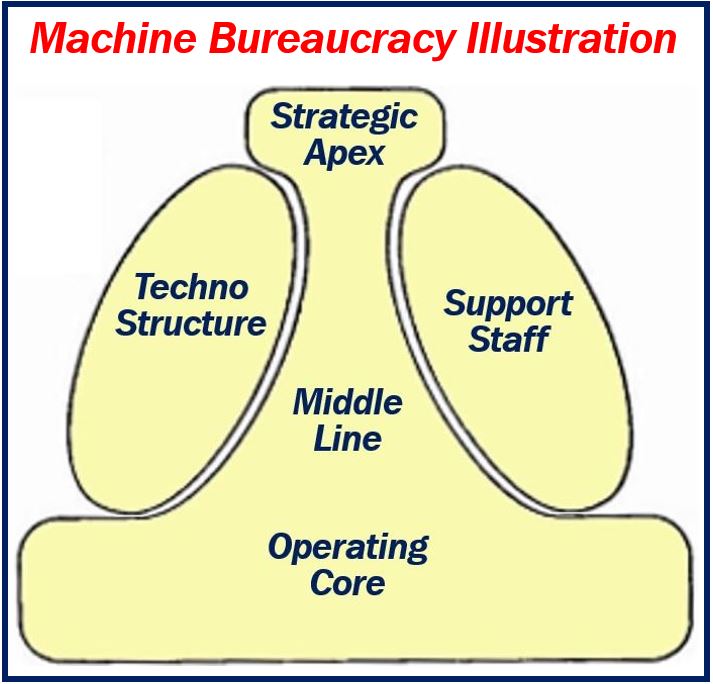A Machine Bureaucracy is a formalized management structure with a high degree of specialization. Senior management makes decisions, which managers and employees at lower levels carry out. Machine bureaucracy is much more common in large, established companies than in startups, young businesses, or SMEs. The letters SMEs stand for small-to-medium (sized) enterprises.
This type of company or organization has what we call a Functional Structure.
Put simply, a machine bureaucracy is a highly structured, formal, and centralized organization.
Machine bureaucracy is the workhorse of large government organizations, heavy industry, and major corporations.

A top-down structure
In this type of organizational structure, top-level management achieve efficiencies through work standardization. It is a very formal, top-down structure. In other words, everything is decided at the top, and delegated vertically.
In this type of structure, decision-making rarely moves sideways.
Reporting lines, like decisions, also move vertically. While decisions move straight down, reporting lines move straight up.
John Lannoye, in a ToughNickel article about Delta Airlines, wrote:
“These types of organizations usually have very formal operating rules with a centralized power structure – meaning power flows from the top. ‘Machine Bureaucracy’ type companies also have elaborate administrative structures that flow between management and front line staff.”
Machine bureaucracy – advantages
For some corporations, this organizational style works well, especially if the company performs routine tasks.
If you work in a large company where following precise specifications and protocols is crucial to achieving goals, a machine bureaucracy structure is effective.
Below are some advantages of this type of structure:
- Specialization: every employee is assigned a specialized task to perform. In other words, everybody knows what they have to do.
- Structure: this sets the pace and frameworking for the functioning of the corporation or organization.
- Predictability and Stability: as everybody knows what they must do, who does it, and who makes decisions, the organizatons has stability.
Disadvantages
- Rigidity: the organization is inflexible. This could be a serious problem if the working environment or marketplace suddenly change.
- Goal displacement: rules regarding organizational goals and objectives at each level become an end to themselves. This could eventually be at the cost of the overall goals and objectives of the company.
- Impersonality: a machine bureaucracy places procedures and compliance above the individual’s emotions and needs.
- Red Tape: this can become a serious problem in large organizations.
- Inter-Departmental Communications is much harder in this type of structure.
A machine bureaucracy is one of many different types of organizational structures. There are also, for example, divisional, flatarchy, and matrix organizations.
Similar terms
The following terms are closely related or share some characteristics of ‘Machine Bureaucracy.’
- Mechanistic Organization: Rigid, hierarchical structure.
- Formal Organization: Emphasizes official, regulated procedures.
- Centralized Organization: Decision-making is concentrated at the top.
- Hierarchical Organization: Power and roles are clearly defined and ranked.
- Administrative Bureaucracy: Focuses on formal rules and authority in management.
Video – What is Machine Bureaucracy?
Watch this educational video! It comes from our sister channel on YouTube – Marketing Business Network, and explains what ‘Machine Bureaucracy’ is using simple and easy-to-understand language and examples.
